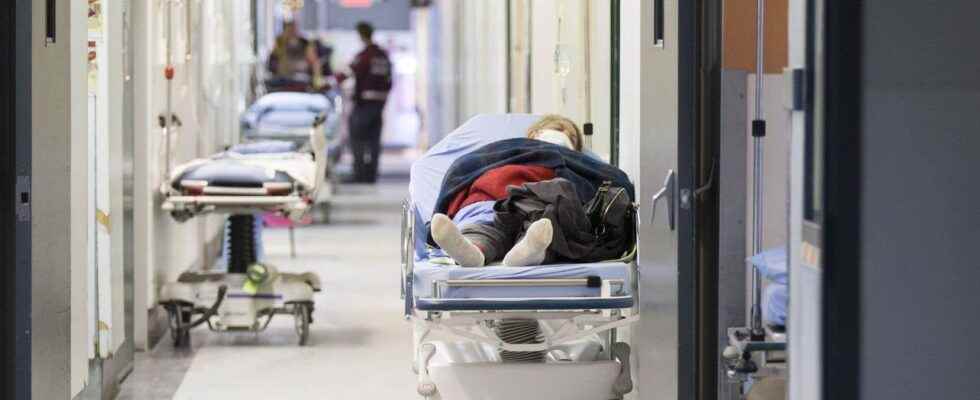In all regions of Quebec, emergency rooms experienced peaks in traffic following Christmas Eve and New Year’s Day, among other things because of respiratory viruses such as COVID-19. With over 130% occupancy across the province, the situation continues to worsen, despite recent government efforts.
“In light of what we observe this morning […]it’s increased traffic due to the holiday season, caused mainly by respiratory viruses, including COVID, “confirmed Tuesday Camille Brochu-Lafrance, communications advisor at the integrated health and social services center (CISSS) of the ‘Outaouais.
The situation remains critical in this region. Tuesday, early afternoon, four of the eight emergency rooms in the Outaouais had occupancy rates above 150%. The Maniwaki Hospital also housed the busiest, at 267% of its capacity.
The Outaouais is far from being an isolated case. In the past 48 hours, emergency room occupancy rates have worsened almost everywhere in Quebec.
In Montérégie, we went from 136% on Sunday to 149% on Tuesday afternoon. Same story in the Laurentians (122% to 170%). However, it was Lanaudière that experienced the worst scenario, increasing occupancy from 135% to 225% in two days.
Slight increase in hospitalizations
The duty reported last week that the three respiratory viruses that caused panic in emergency rooms this fall, namely COVID-19, influenza and respiratory syncytial virus, were slowing their progression, according to the latest data from the National Institute of Public Health of Quebec (INSPQ) updates on December 29.
Certainly, but the INSPQ also observes a slight increase in the number of current hospitalizations linked to COVID-19 in Quebec. 1,716 non-intensive care hospitalizations were recorded on November 22, compared to 2,064 on December 22. In intensive care, we went from 44 to 55 hospitalizations in the same period. New data for the last few weeks will be available on Thursday.
Each year, the months of January and February are the busiest in emergencies. It is therefore a safe bet that when the holidays return, this upward trend will continue, if only for the next few weeks.
A new sub-variant to watch out for
This is without taking into account that the Omicron XBB.1.5 sub-variant, which spreads very quickly south of the border, could also knock on Quebec’s doors. Last Friday, the US Centers for Disease Control and Prevention (CDC) announced that it now accounts for 40.5% of the country’s COVID-19 cases. For the moment, the INSPQ does not provide data on XBB.1.5 in particular.
The CDC says it “may be more transmissible than other variants,” but doesn’t know if it causes “more severe” symptoms. This is because XBB.1.5 has a mutation that causes what scientists call “immune escape,” which means it’s more effective against immune people, including vaccinated people.
The INSPQ recalls, however, that “the effectiveness of the vaccine in preventing hospitalization increases with the number of doses”, regardless of the sub-variants of Omicron studied so far. People who have been infected previously and who have been vaccinated also have “an immunity greater than vaccine immunity alone or post-infection immunity alone”, still according to the INSPQ.
What are the effects of “overcapacity plans”?
Faced with the difficult situation in the province’s emergency rooms, the Quebec government introduced “overcapacity plans” in December so that the floors can accommodate more patients when the emergency room is overflowing. These measures were first implemented in Greater Montreal, and are gradually spreading elsewhere in Quebec.
“The overcapacity plans are in effect and given the number of users on stretchers, they are almost permanent at the moment,” explains Sara Gauthier, information officer in the communications department of the CISSS de Lanaudière.
The CISSS declined to comment further. However, we can deduce that the recent government measures work to varying degrees depending on the region and the needs of patients. As the holidays approach, we also set up an 811 pediatric line, as well as five specialized nurse practitioner (SNP) clinics.
The province’s hospitals can also contribute to relieving emergency room congestion, as confirmed by Carl Boisvert, communications advisor at the CIUSSS de l’Est-de-l’Île-de-Montréal. “We are working to reduce the length of hospital stays as much as possible, to plan discharges as soon as possible in a safe manner for patients and to encourage waiting for accommodation at home. »
In addition, this CIUSSS directs “as much as possible towards ambulatory services patients who come to the emergency room and whose state of health allows them to be redirected [vers des] GMF, CLSC, IPS clinic, GAP,” adds Mr. Boisvert. Emergency rooms are still occupied at 135% of their capacity on the island of Montreal, a little above the provincial average.
